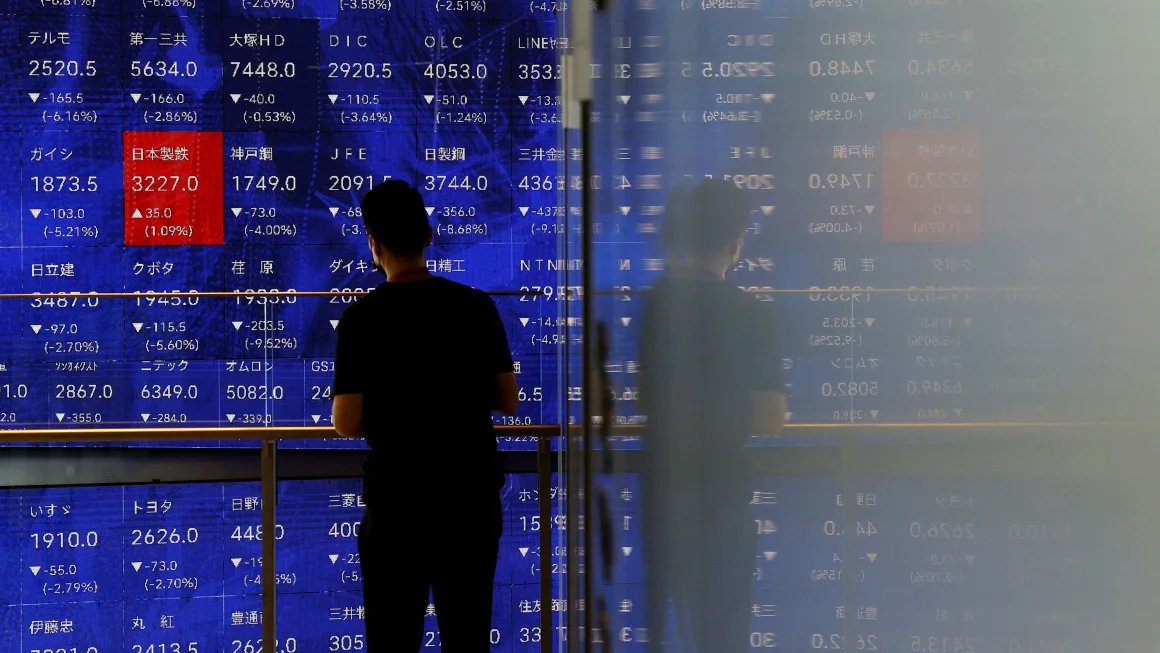Japanese stocks suffered their biggest ever daily loss Monday as fears about a US economic slowdown sent shock waves through global markets.
The Nikkei 225 index of leading stocks in Tokyo lost a staggering 4,451 points, its biggest drop in history. The index closed more than 12% down, taking its losses since early July to 25% and entering bear market territory.
“That was a crash. It smelled like 1987,” Neil Newman, head of strategy at Astris Advisory in Tokyo, told CNN. He was referring to “Black Monday” in October 1987, when global markets plunged and the Nikkei lost 3,836 points.
Fears of a sharp slowdown in the US economy have raised expectations that the Federal Reserve will have to slash interest rates. Coming as the Bank of Japan (BOJ) takes its interest rates higher to contain inflation, that is boosting the value of the yen against the US dollar and making Japanese export-dependent stocks less attractive.
At the same time, tech stocks are being hammered by a combination of mixed earnings and increasing skepticism among some investors about the hype around artificial intelligence.
“The buzz is all about the contagion effect of this aggressive bear onslaught, underscored by fears of a hard landing in the US and a severe meltdown in Tokyo’s markets, which now appear to be self-perpetuating,” said Stephen Innes, managing partner of SPI Asset Management.
Trading was halted for short periods of time in Japan and South Korea as circuit breakers designed to prevent panic selling were triggered multiple times.
“(Today) was relentless,” said Newman. “It was unusual because there was the absence of a rebound at the end of the day, which you would normally see due to short covering,” he added. That’s when traders buy back shares they have borrowed to sell.
The volatility spread to other markets in Asia and Europe, and US stock futures fell sharply overnight. Nasdaq futures were down 4%. Dow futures and S&P 500 futures were down 1.5% and 2.3% respectively.
Global rout
The Stoxx Europe 600 index, the region’s benchmark, was 2.5% down in morning trade. It has fallen 6% in the past five days to lows last seen in February.
Mohit Kumar, an economist at Jefferies, said a big driver of recent market moves was previous enthusiastic buying. “US equities, particularly the tech sector, (were) overowned and some froth needed to be cleared,” he wrote in a note Monday.
Taiwan’s Taiex ended down 8.4%, its worst day ever, while South Korea’s Kospi finished 8.8% lower. Australia’s S&P/ASX 200 lost 3.7%. Hong Kong’s Hang Seng Index and China’s Shanghai Composite were down 2.3% and 1.3% respectively.
The volatility in Japan started last week, when the BOJ raised interest rates for the second time this year and announced plans to taper its bond buying. Traders expect more rate hikes to come later this year as the central bank tries to contain inflation.
The Nikkei closed down 5.8% Friday, as traders fretted about the impact of a stronger yen on Japanese companies. A rising yen would hurt exporters and companies with overseas earnings.
A rapid appreciation in the Japanese currency has also forced many market participants to unwind the yen carry trade, a hugely popular trading strategy. With interest rates having been extremely low in Japan for decades, many investors have borrowed cash cheaply there before converting it to other currencies to invest in higher-yielding assets.
Last week, the yen surged nearly 5% against the greenback. On Monday, it strengthened further, up 2.2% to trade at 143.3 per US dollar.
Innes said the “beefier” yen triggered a global unwinding of carry trades.
From there, the market turmoil morphed into a “full-on avalanche,” propelled by the surprisingly hawkish turn from the BOJ, China’s economy slowing to a crawl and weak US tech earnings, he added.
Slew of factors
China reported last Wednesday that its official manufacturing PMI fell in July, signaling continued weakness in factory activity.
In the United States, Amazon (AMZN) reported Thursday an earnings miss for the second quarter and disappointing guidance for the third quarter. Intel (INTC), on the same day, reported an income loss of $1.6 billion in the second quarter and announced plans to slash 15% of its workforce to reduce costs.
US stocks had already ended Friday lower, as disappointing jobs data added to fears that the US economy is weakening. The Dow closed 1.5% lower, the S&P 500 lost 1.8% and the Nasdaq Composite declined 2.4%. The Nasdaq closed in correction territory, or more than 10% off its most recent high on July 10.
CNN’s Fear and Greed index, which measures market sentiment, has fallen to a “fear” reading of 27.
Other markets are also showing jitters. On Friday, oil prices settled at their lowest levels since January. Brent crude futures and US WTI crude were both down more than 3%.
Currently hovering around eight-month lows, oil prices may see some stability for the time being, despite threats of a wider conflict in the Middle East, according to Tom Kloza, global head of energy analysis at Oil Price Information Service.
“Beginning with the Hamas action last October 7, we are seeing mostly apathy when it comes to fears about a wider regional war in the Middle East,” he said.
Crypto currencies haven’t been immune, either. Bitcoin was down more than 12% at just under $53,000, according to Coindesk.

